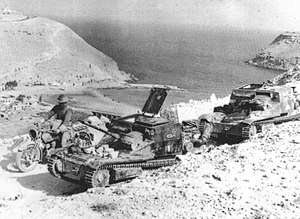
The Maletti Group had L3/35 tankettes, like the one destroyed (on the right) outside Bardia in 1941.
The Maletti Group (Raggruppamento Maletti) was an ad hoc "mechanized" unit formed by the Italian Royal Army (Regio Esercito) in Italian North Africa (Africa Settentrionale Italiana, or ASI) during the initial stages of the Western Desert Campaign of World War II. The group was formed in June 1940 and was destroyed in December of the same year.[1]
Western Desert Campaign[]
The Maletti Group was commanded by General Pietro Maletti and was part of the Libyan Corps, also known as the "Royal Corps of Libyan Colonial Troops" (Regio Corpo Truppe Coloniali della Libia). The group itself was composed of six battalions of Libyan infantry and of two battalions of armor. The 2,500 Libyans were "mechanized" in that they were transported in trucks. One armor battalion had thirty-five L3/33 and/or L3/35 tankettes. The other had thirty-five M11/39 medium tanks.[2]
During the very early stages of the North African Campaign, the Maletti Group took part offensively in the Italian invasion of Egypt and defensively during the British counterattack known as Operation Compass. In September 1940, the group acted as a flank guard and led the Italian advance from Libya into Egypt.[3] By December, the group was in defensive positions at the Nibiewa Camp near Sidi Barrani. Many of the armored vehicles were "dug in" and acted as stationary pillboxes. The Maletti group was considered the 3rd Libyan Division in the initial Italian attack to Egypt, together with the 1st Libyan Division Sibelle and the 2 Libyan Division Pescatori.
The Maletti Group was earmarked for early destruction by the British. During the initial attack, Matilda infantry tanks of the 7th Royal Tank Regiment exploited a hole in the Italian defensive positions and attacked the Nibiewa camp from the rear. The Maletti Group was destroyed and General Pietro Maletti was killed in action while trying to stop the sudden attack:
The initial British assault would fall on Nibeiwa Camp, where the only available Italian armoured unit was based, and it achieved complete surprise. Raggruppamento Maletti, or Maletti Group, under General Maletti, was an ad hoc formation consisting of 2,500 Libyan soldiers and 2 Armoured Battalion, with thirty-five M11/39 medium tanks and thirty-five L3/35 light tanks. It was earmarked for early destruction in the assault, which commenced at 05:00hr with what appeared to be no more than another raid on the eastern side of the camp. At 07:00, however, forty-eight Matilda tanks suddenly appeared from the opposite side of the camp. They struck twenty-three unmanned M11/39 tanks of the Maletti Group, which had been deployed to guard the unmined entrance to the camp. The Italians were caught completely off guard and many did not even reach their tanks, including General Maletti, who was killed emerging from his dugout. They were slaughtered and their vehicles destroyed by the British in less than ten minutes. The Italian artillery fought on valiantly, firing on the Matildas and recording many hits, some at point-blank range - but none penetrated their 70 mm of armour. The remaining Italian tanks were captured intact, and the Libyan infantry, left practically defenceless, quickly surrendered. The British had captured Nibeiwa and destroyed the only front-line Italian armoured unit in less than five hours.[4]
The Operation Compass attack on Maletti Group was supported by 25 pounder artillery and Blenheim bombers and was centred on the advance of Mk.II Matilda tanks. Within an hour of the onset of combat Italian General Pietro Maletti was dead and 4,000 Italian soldiers (most of them Libyan colonial troops) had surrendered. Within three days, the attacking forces then moved west along the Via della Vittoria, through the Halfaya Pass and captured Fort Capuzzo, Libya.
See also[]
- Pietro Maletti
- Military history of Italy during World War II
- Motorised infantry
- 7th Royal Tank Regiment
- 4th Indian Infantry Division
- 1st Libyan Division Sibelle
- 2 Libyan Division Pescatori
References[]
- ↑ First Italian offensive in Egypt (in Italian)
- ↑ Walker. Iron Hulls, Iron Hearts, p. 61
- ↑ Macksey. Beda Fomm, p. 38
- ↑ Walker.Iron Hulls, Iron Hearts p. 62
Sources[]
- Macksey, Major Kenneth (1971). Beda Fomm: Classic Victory. Ballentine's Illustrated History of the Violent Century, Battle Book Number 22. Ballantine Books.
- Walker, Ian W. (2003). Iron Hulls, Iron Hearts : Mussolini's elite armoured divisions in North Africa. Marlborough: Crowood. ISBN 1-86126-646-4.
- Wavell, Archibald (1946). Despatch on Operations in the Middle East From August, 1939 to November, 1940. London: War Office. in "No. 37609". 13 June 1946. https://www.thegazette.co.uk/London/issue/37609/supplement/
- Wavell, Archibald (1946). Despatch on Operations in the Western Desert From 7th December, 1940 to 7th February 1941. London: War Office. in "No. 37628". 26 June 1946. https://www.thegazette.co.uk/London/issue/37628/supplement/
- Walker, Ian W. Iron hulls, iron hearts: Mussolini's elite armoured divisions in North Africa. Crowood. Marlborough, 2003 ISBN 978-1-86126-646-0.
External links[]
- "Archibald Wavell's Despatch on Operations in the Middle East From August, 1939 to November, 1940.". Supplement to the London Gazette, Number 37609. June 13, 1946. http://www.ibiblio.net/hyperwar/UN/UK/LondonGazette/37609.pdf. Retrieved October 31, 2009.
- "Archibald Wavell's Despatch on Operations in the Western Desert From 7th December, 1940 to 7th February 1941.". Supplement to the London Gazette, Number 37628. June 26, 1946. http://ibiblio.org/hyperwar/UN/UK/LondonGazette/37628.pdf. Retrieved October 31, 2009.
The original article can be found at Maletti Group and the edit history here.